The two Ukrainian soldiers lived on Myru Street in the village of Zdvyzhivka in Kyiv Oblast. Pavlo Kholodenko and Viktor Balay had known each other since early childhood. They grew up together, played together, and went to kindergarten and primary school together. When war broke out in eastern Ukraine in 2014, they enlisted together and fought in the Donbas as part of the Kyivshchyna Police Battalion.
When Russia launched a full-scale invasion of Ukraine on 24 February, 2022, Pavlo and Viktor dropped their daily duties and rushed over to the local recruitment office. Then, in early March, they suddenly stopped communicating with their families.
“There was no news, but we knew they were probably together. They were best friends, very close, always together. They were inseparable,” says Tetiana Kholodenko, Pavlo’s mother.
During the first week of April, Russian troops began retreating from Kyiv Oblast, but it is only recently that the bodies of both ATO veterans were found buried in a trench near their village. The two men had been tortured, mutilated and shot point blank in the head.
Volunteers in the ATO zone of the Donbas
In May 2014, Pavlo Kholodenko and Viktor Balay joined a volunteer unit and underwent military training. In mid-June, they were deployed to the ATO zone as part of the Kyivshchyna Police Battalion. Pavlo’s mother recalls that they spent almost two years fighting in the Donbas. They came home on leave together and returned to their fighting unit together.
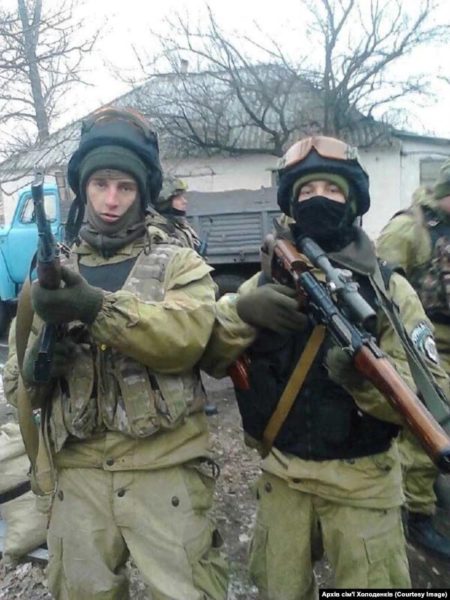
When Russia invaded Ukraine at the end of February 2022, Pavlo and Viktor went to the military recruitment office in neighbouring Borodianka.
“I begged my grandson not to go. I told him he’d already done his duty… but Viktor said he’d taken the oath of allegiance to his country and couldn’t just sit at home, doing nothing,” says Olha Dovholap, Viktor’s grandmother.
Shortage of weapons for Ukrainian soldiers of the Territorial Defense Force
Despite their willingness to fight, the two men were unable to enlist at the recruitment office in Borodianka. Eyewitnesses testify that on 25 February the office was overcrowded with men wanting to enlist; the queue of men – young and old - stretched all the way down the street.
The two young men were told that the local Territorial Defense Unit had enough men. The recruitment office closed and Pavlo and Viktor were left with nothing. As it was getting dark, they decided to spend the night in the village church.
That same evening, the village of Zdvizhivka was occupied by Russian forces. The invaders set up their camp in the forest on the outskirts of the village, from where they planned to launch an attack on Kyiv.
According to eyewitnesses, thousands of Russian soldiers and masses of military hardware were stationed on the outskirts of Zdvizhivka. The forest area still bears the scars of occupation – ugly trenches and dugouts among the green trees and bushes.
“In the first days of the war, in just two hours, I counted about half a thousand units of different Russian vehicles moving through the village. Not just once, but several times…” recalls Pavlo’s brother Ivan Kholodenko.
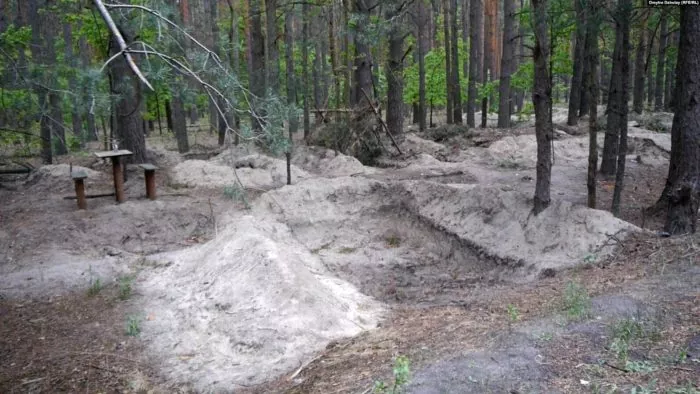
On the way home to Zdvizhivka
Pavlo and Viktor spent the night in Borodianka and on 26 February, they continued towards the next village Babyntsi. The men decided to spend the night at a friend’s place in Babyntsi as it was too dangerous to travel at night.
“You’d better not go to Zdvizhivka. There are a lot of Russians here, a lot of military hardware, equipment, and checkpoints. They won’t let you through,” said Ivan to his brother Pavlo over the phone.
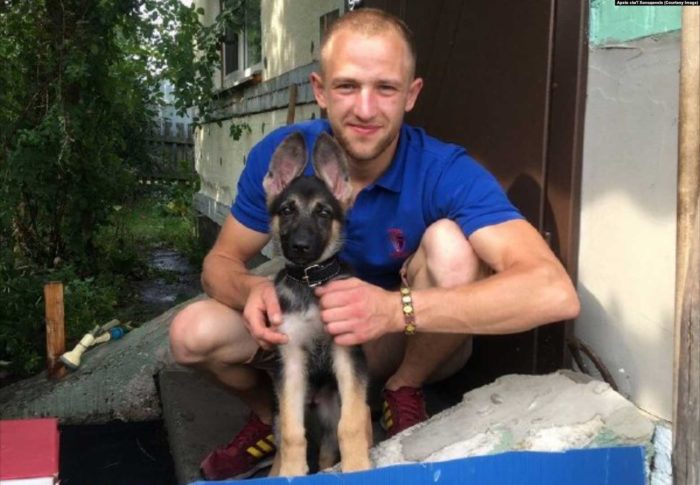
Of course, Pavlo and Viktor were very worried about their families in occupied Zdvizhivka. They were familiar with the surroundings, so they decided to try to reach the village through the neighbouring forest.
After 4-5 March, there was no more news from either Pavlo Kholodenko or Viktor Balay.
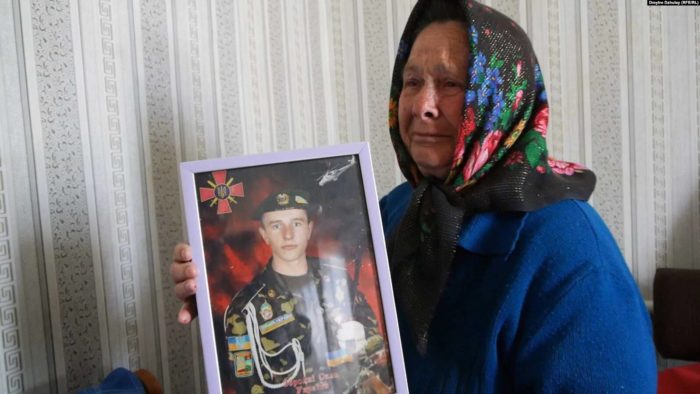
Two mutilated bodies in a trench
On 15 March, when Zdvizhivka was still under the control of the Russian army, a local resident, Ihor and his neighbour were in the forest searching for a mobile signal and rations left by Russian soldiers.
“On our way back, we came across many trenches abandoned by the Russian soldiers. I looked closely at one and saw part of a leg with a rubber shoe sticking out from the sand, which covered most of the pit. We couldn’t see anything else.”
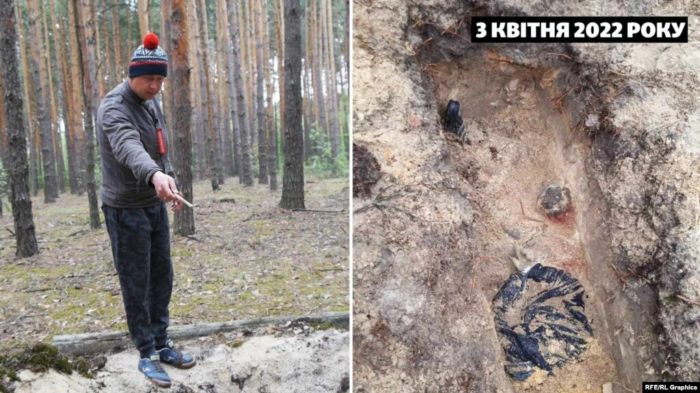
Ihor and his neighbour did not report anything as their area was still under Russian occupation, but they could not forget what they had seen. In April, when Russian troops withdrew from Zdvizhivka, Ihor returned to the trench with a local UOC priest, Father Vasyl, and several other villagers.
“We dug up the bodies very slowly and carefully. We looked at them closely and realized they were our boys, young guys from our village. I recognized Viktor by his clothes, but I wasn’t sure about Pavlo. However, I knew that one couldn’t be without the other.”
Relatives soon identified the bodies and confirmed that Pavlo Kholodenko and Viktor Balay had been found dead in a Russian trench.
“Both of them had their hands tied behind their backs, and Viktor was blindfolded. Their bodies were mutilated. It was evident that they’d been tortured,” stated Father Vasyl.
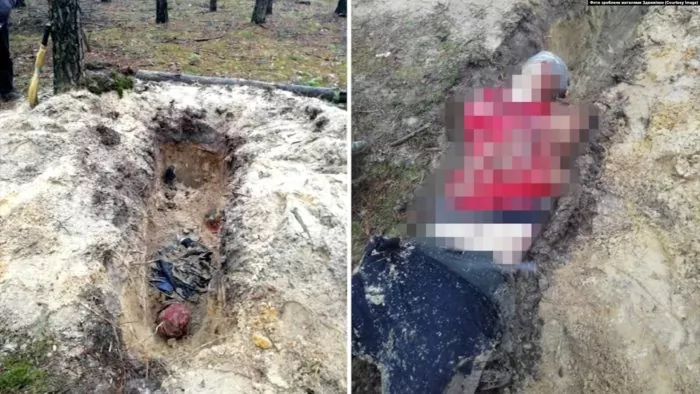
Ihor confirmed the priest’s testimony. The bodies were black and blue; the men’s teeth had been torn out. Both men had been killed by a bullet to the head.
After exhumation and close investigation, the Kyiv Regional Bureau of Forensic Medical Examination issued a death certificate to the families: “Cause of death - Gunshot wound to the head. Circumstances of death - military aggression of the Russian Federation”.
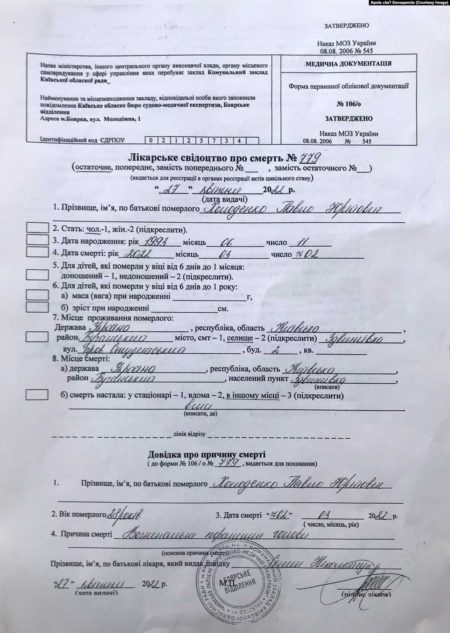
“I ask my son to come to me in my dreams…”
Pavlo’s brother Ivan still imagines that he will see his brother walking down the road towards the family home. Ivan saw Pavlo in his dreams after the funeral and clrearly heard him saying that he was far from home, fighting for his country… and asked his brother for some cigarettes.
Every night, Pavlo’s mother looks at the two photos of her son that are still on her phone, and asks him to come to her in her dreams:
“Come into my dreams, my dearest son! Tell me how it happened? How long did they keep you there? How long did they torture you?… It’s so hard for me to think that Pavlo and Victor spent their whole lives together, were captured and tortured together and were finally buried together in one pit.”
Pavlo Kholodenko and Viktor Balay were laid to rest in Zdvizhivka, but in different cemeteries. They were both 28 years old.
On 24 February, 2022, Russia launched a full-scale invasion of Ukraine from three directions. Russian troops entered Kyiv Oblast from Belarus with the intention of capturing the capital. In the south, the Russian army occupied parts of Zaporizhzhia and Kherson Oblasts, and in the north – some areas of Sumy and Chernihiv Oblasts. Russian President Vladimir Putin called the invasion a “special operation”. Initially, the goal was to “demilitarize and denazificate” Ukraine; later, theKremlin rhetoric changed - to “protect the Donbas”. Russian authorities claim they do not target or bomb civilians. At the same time, Russian aircraft, ground and navy forces shell and bomb Ukrainian cities every day. Private homes, apartment buildings and civil infrastructure in Mariupol, Kharkiv, Chernihiv, Zhytomyr, Sievierodonetsk, Kyiv and many other Ukrainian cities, towns and villages are being destroyed daily. Unable to take the capital city, the Russian army withdrew from Kyiv, Chernihiv, and Sumy Oblasts in early April. After the liberation of Kyiv Oblast from Russian troops, the world witnessed first-hand concrete facts of mass murder, torture and rape of civilians, including children - in Bucha, Irpin, Hostomel and neighbouring towns and villages. The same atrocities were documented in the liberated areas of Chernihiv Oblast. Mass grave sites have been documented in the occupied regions of Donetsk Oblast. Ukrainian authorities claim that Russia is committing genocide. Investigative teams and specialists from western countries are documenting the facts of the massacres. Russia continues to deny any charges of war crimes and says the Bucha killings were “staged”. As of 30 May, 2022, the Office of the United Nations High Commissioner for Human Rights confirmed 8,900 civilian casualties: 4,074 killed and 4,826 injured. However, the actual figures are probably higher, as the receipt of information from some locations with intense hostilities has been delayed and many reports are still pending corroboration. This concerns Mariupol (Donetsk Oblast), Izium (Kharkiv Oblast), Popasna, Sievierodonetsk and other locations in Luhansk Oblast, and many more.
Read more:
- Snyder: Ten reasons Ukraine should win the war
- Russian attack on Ovruch: greenhouses bombed, death, devastation, and ruins all around.
- Russia’s war crimes in Chernihiv Oblast: “They were beaten, tortured & executed…”
- Russian war crimes in Katiuzhanka: torture chamber, toilets in classrooms, and stolen lingerie
- “At first, I did not want to live.” Ukrainian nurse got married after Russian mine took her legs
- Fallen pilots who saved the Ukrainian Air Force
- Cruelty, murder, and destruction in Bucha

